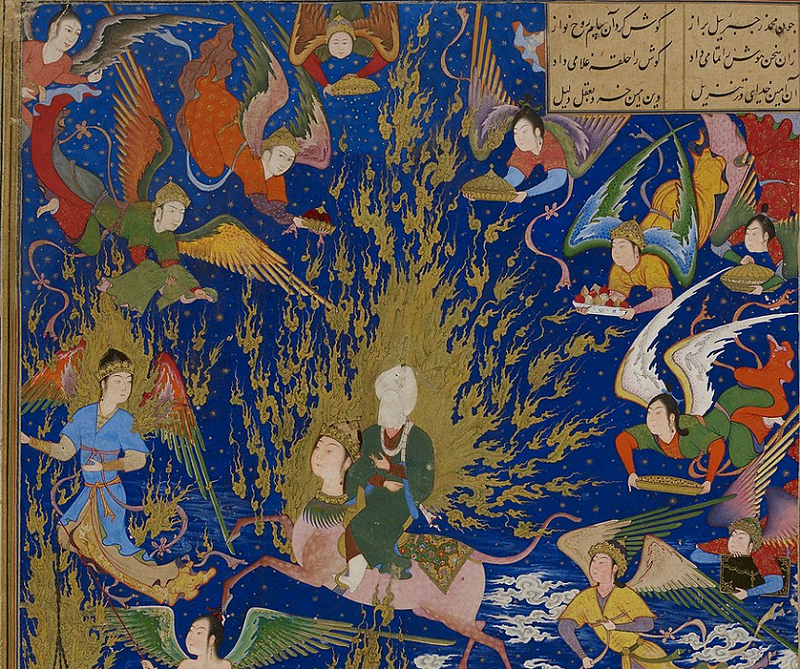Dr. Jack Wheeler
THE TERRACE OF INFINITY
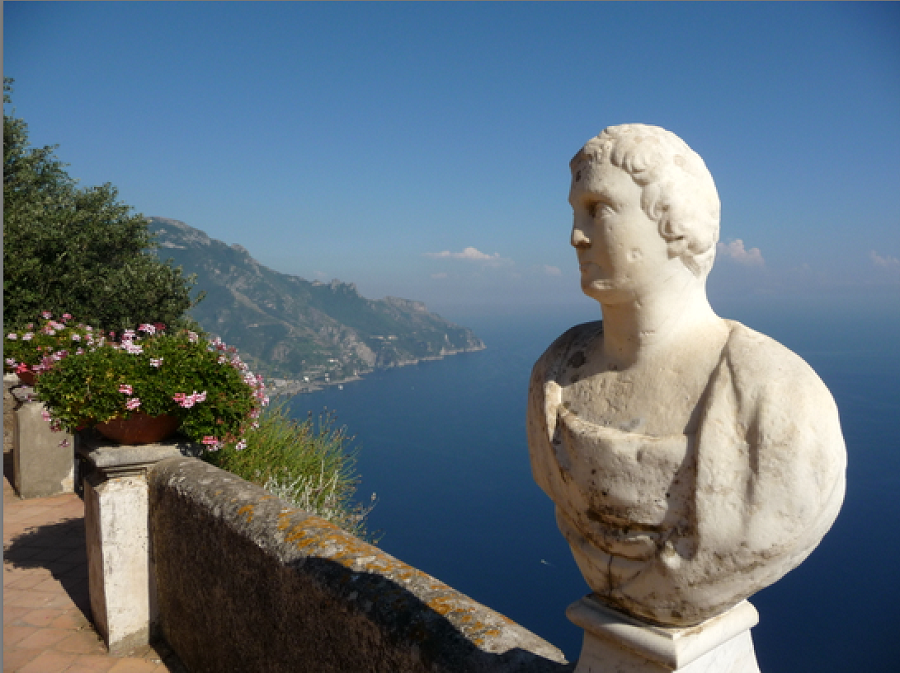 Over a thousand feet on a mountain ledge above Amalfi on the Mediterranean, you’ll find the Terrazzo dell'lnfinito, considered by poets for centuries the most beautiful view in the world. It is part of the magnificent gardens of the 11th century Villa Cimbrone, in the hilltop town of Ravello, built by the Romans in the 5th century.
Over a thousand feet on a mountain ledge above Amalfi on the Mediterranean, you’ll find the Terrazzo dell'lnfinito, considered by poets for centuries the most beautiful view in the world. It is part of the magnificent gardens of the 11th century Villa Cimbrone, in the hilltop town of Ravello, built by the Romans in the 5th century.
The Sorrentine Peninsula is a finger of land south of Naples sticking out into the Med’s Tyrrhanean Sea, off the tip of which is the legendary island of Capri. The main town of Sorrento is on the north side facing Naples and Mount Vesuvius. But it is the steep southern shore of the Amalfi Coast that is our planet’s most spectacularly scenic drive with its ancient ports of Amalfi and Positano.
Exploring this magical part of the world is an ultimate “bucket list” experience. And to top it off, on the way down from Naples, you get to visit Pompeii, the excavated Roman city buried and preserved by the ash of Vesuvius in 79 AD. (Glimpses of Our Breathtaking World #115 photo ©Jack Wheeler)
THE EYELASH AT DAWN
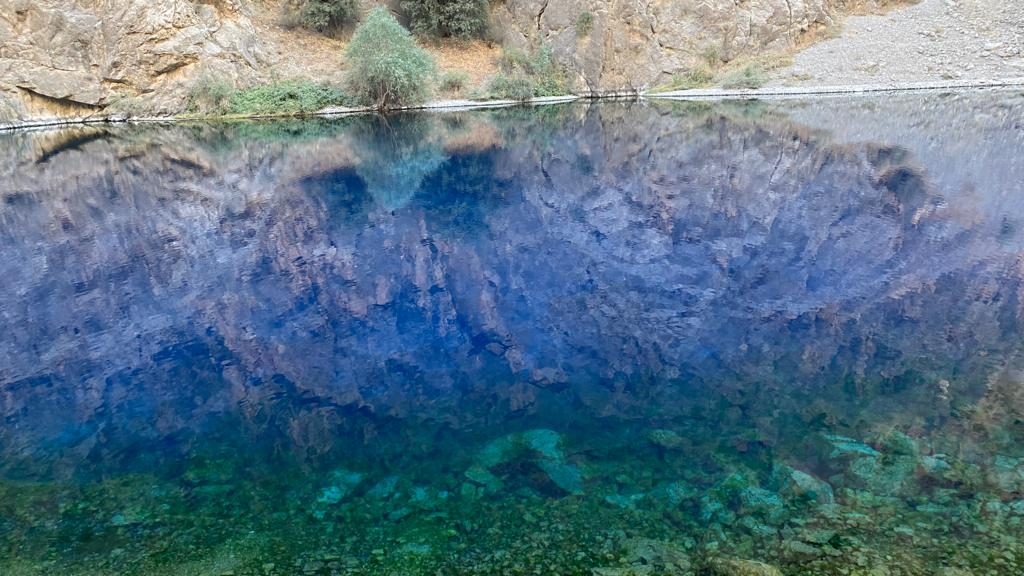 The first of The Seven Pearls of Shing is called Mijnon or The Eyelash. It’s at 5,300 ft in the Fann Mountains of Western Tajikistan. At dawn, the air is still and crystal clear as is the water. The surface of the lake becomes a mesmerizing mirror with the early light reflecting the vertical cliffs above while penetrating to the translucent lake bed below. It is an epic example of the boundless beauty of our world.
The first of The Seven Pearls of Shing is called Mijnon or The Eyelash. It’s at 5,300 ft in the Fann Mountains of Western Tajikistan. At dawn, the air is still and crystal clear as is the water. The surface of the lake becomes a mesmerizing mirror with the early light reflecting the vertical cliffs above while penetrating to the translucent lake bed below. It is an epic example of the boundless beauty of our world.
Yet Tajikistan is only one of the “Stans” of Central Asia, an ultimate of the world’s mysterious, remote, and wondrous places. There are four others: Kazakhstan, Kyrghistan, Uzbekistan, and Turkmenistan. A number of your fellow TTPers have been there with me and can tell you what a fabulously life-memorable adventure it is to explore all five.
We’ll be there again sometime soon. Be with us with your loved one, your children, or grandchildren and you’ll all have an experience to treasure for all of your lives. (Glimpses of Our Breathtaking World #263 photo ©Jack Wheeler)
THE MOSLEM MYTH OF JERUSALEM
[This Monday’s TTP Archives feature was originally published on December 3, 2003. "From the river to the sea," the Palestinian battle cry that woke Wikipedia describes as an Arabic "focus on freedom," is based on the lie that Jerusalem is one of the holy sites of Islam. While the libs weep over Israel's "aggression" against the Palestinians "who just want peace," let's take another look at the evidence for the Moslem claim]
It is a commonplace in a story or article about the Arab-Israeli conflict that mentions Jerusalem to repeat the Moslem mantra that “Jerusalem is the third holiest city in all Islam, next to Mecca and Medina.”
You’ve heard this innumerable times — but how come? Just why is Jerusalem so important to not just Jews and Christians but Moslems as well?
The reason is one single line in the Koran. If it can be shown by Islamic scholars that it has been misinterpreted, then Jerusalem ceases to be a holy city to Islam.
BALLOONS OVER BURMA
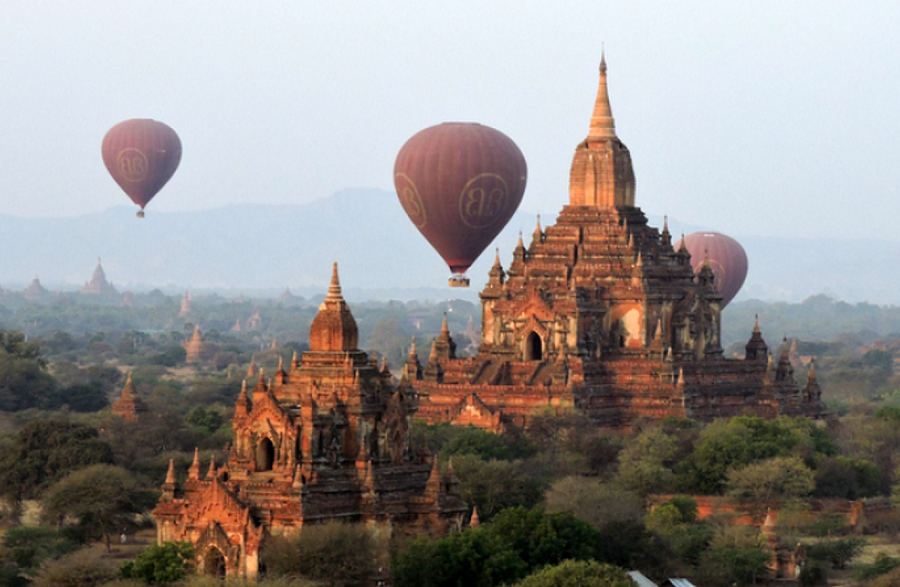 From the 900s to the 1200s, the Pagan Empire built over 10,000 Buddhist temples. 2,200 remain on the plains of Pagan today, one of the world’s most wondrous sights – especially if you see them from above in a hot air balloon. It is truly astounding how much there is to explore and experience in Burma. Hopefully, we’ll be there once more for it all next February. I hope you will be one of your fellow TTPers to join us. (Glimpses of Our Breathtaking World #33 photo ©Jack Wheeler)
From the 900s to the 1200s, the Pagan Empire built over 10,000 Buddhist temples. 2,200 remain on the plains of Pagan today, one of the world’s most wondrous sights – especially if you see them from above in a hot air balloon. It is truly astounding how much there is to explore and experience in Burma. Hopefully, we’ll be there once more for it all next February. I hope you will be one of your fellow TTPers to join us. (Glimpses of Our Breathtaking World #33 photo ©Jack Wheeler)
FLASHBACK FRIDAY – WITH MBUTI PYGMIES IN THE CONGO
 August, 1971. The gentle Mbuti people live in the Ituri rainforest, one of the world’s densest jungles, in northeastern DR Congo. They are among the most ancient of all human populations, with their ancestors having hunted in these forests for over 60,000 years. The tallest among them is under five feet.
August, 1971. The gentle Mbuti people live in the Ituri rainforest, one of the world’s densest jungles, in northeastern DR Congo. They are among the most ancient of all human populations, with their ancestors having hunted in these forests for over 60,000 years. The tallest among them is under five feet.
It was on my first visit to Africa that I was able to spend time with them. They live in scattered bands of a few dozen each, always on the move in search of game, sleeping in small makeshift huts of branches and leaves, and far away from villages of Bantus who always try to enslave them.
Their music is hypnotic. To the beat of drums of hollowed-out logs, they sing with a polyphonic complexity that is extraordinary. I’ll never forget the performance they gave for me. Alas, no tape recorder – much less videocam back then! (Glimpses of Our Breathtaking World #65 photo ©Jack Wheeler)
HALF-FULL REPORT 04/25/25

Ouch. The NY Post cover story this morning (4/25) has to bruise our POTUS whose ego is the size of Olympus Mons on Mars.
On Wednesday night (4/23)/early Thursday morning (4/24), in clear response to Trump’s “final peace proposal,” Russia launched a massive missile attack on civilian targets in Ukraine’s capital of Kyiv: at least 70 missiles 11 of which were ballistic, and close to 150 kamikaze drones, blowing up a number of residential apartment complexes leaving many dead in the rubble and hundreds wounded (the photo in the NYP cover is one of them).
This video shows the moment a North Korean ballistic missile struck a residential building in Kyiv last night, killing 12 ppl
While Ukraine has been out of U.S. ATACMS & British/French Storm Shadows for months, North Korea keeps sending KN-23 ballistic missiles to Russia🇺🇦🇰🇵🇷🇺 pic.twitter.com/vQlJYrUauQ
— Visegrád 24 (@visegrad24) April 24, 2025
Trump’s response on his Truth Social?
So much more in this HFR – it will make you think, laugh, get upset, think and reflect more, laugh more, and find news that will make you happy. Jump right on in!
THE TIGERS OF SAMARKAND
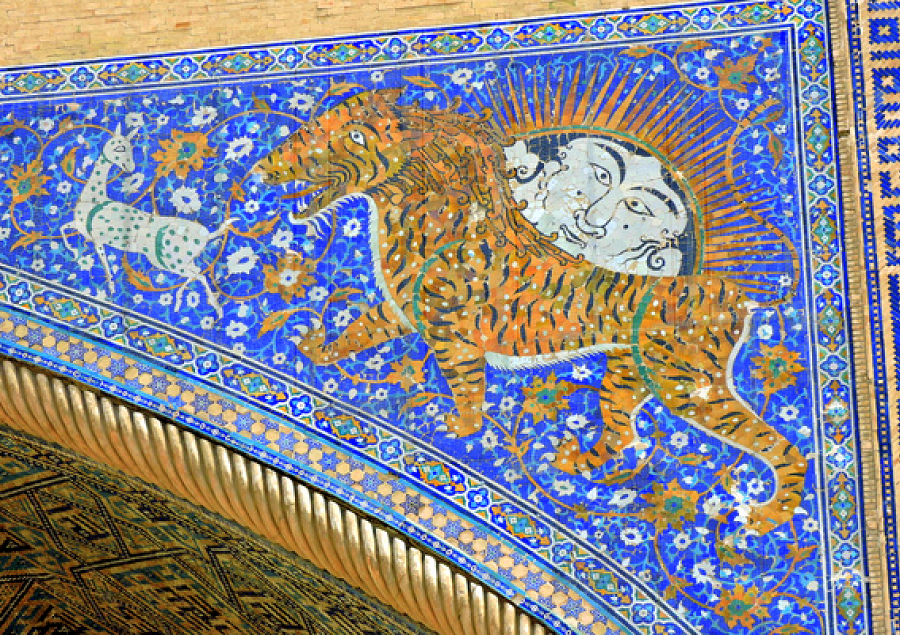 The magnificent Sher-Dor Madrassa, built in the early 1600s, is part of the Registan public square complex of the ancient Silk Road oasis of Samarkand. “Sher-Dor” means “Adorned with Tigers” in Persian – flaunting Islamic blasphemy of living beings in art. Here is the mosaic depiction of a tiger chasing a deer and on its back a rising sun deity with a human face. This is honoring the pre-Islamic history of Samarkand that goes back almost 3,000 years.
The magnificent Sher-Dor Madrassa, built in the early 1600s, is part of the Registan public square complex of the ancient Silk Road oasis of Samarkand. “Sher-Dor” means “Adorned with Tigers” in Persian – flaunting Islamic blasphemy of living beings in art. Here is the mosaic depiction of a tiger chasing a deer and on its back a rising sun deity with a human face. This is honoring the pre-Islamic history of Samarkand that goes back almost 3,000 years.
It was centuries old when Alexander conquered it in 329 BC. For a thousand years as Central Asia’s great entrepot on the Silk Road between China and the Mediterranean, it was a cosmopolitan center for Hinduism, Buddhism, Judaism, Zoroastrianism, and Nestorian Christianity. Incorporated into the Islamic world in the 700s, sacked by Genghiz Khan in 1220, rebuilt by the time Marco Polo in 1272 described it as “a large and splendid city,” Tamerlane made it his capital in 1370.
Colonized by Czar Alexander II in the 1860s within the Russian Imperial Empire, and by the Soviets in the 1920s within the Uzbek SSR, Samarkand is flourishing today in independent Uzbekistan. Come with me to explore Samarkand and so many other wonders of "The Heart of Central Asia" soon. It will be like a dream come true. (Glimpses of Our Breathtaking World #208 photo ©Jack Wheeler)
THE FAIRY TALE CASTLE OF SEGOVIA
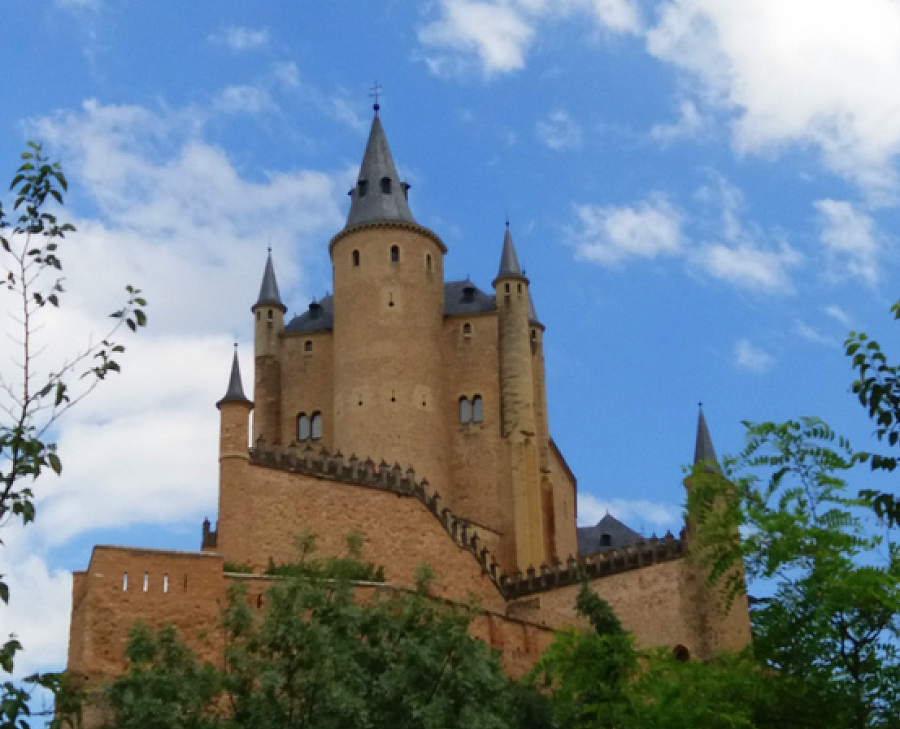 This is Spain’s most famous and beloved castle, high on a rocky promontory above the city of Segovia some 60 miles northwest of Madrid. The site of a Celtic settlement, Roman trading post, and Arab wooden fort, when the Reconquista of the Christian knights removed the Islamic invaders from their land in the early 1200s, the building of the idyllic fairy tale castle you see began.
This is Spain’s most famous and beloved castle, high on a rocky promontory above the city of Segovia some 60 miles northwest of Madrid. The site of a Celtic settlement, Roman trading post, and Arab wooden fort, when the Reconquista of the Christian knights removed the Islamic invaders from their land in the early 1200s, the building of the idyllic fairy tale castle you see began.
For centuries it was the palace residence of the Kings and Queens of Castille. It was here, on December 13, 1474, that Isabella, daughter of King John II, was enthroned as the Queen of Castille. When her husband Ferdinand, whom she married in 1469, became King of Aragon in 1475, they jointly ruled a unified Spain. As we learned in our early school years, it was Ferdinand of Aragon and Isabella of Castille who sponsored Columbus’ discovery of the Americas in 1492.
Today, the Castle of Segovia is a World Heritage Site, serving as a museum of the history of Castille and National Archive of Spain. Immaculately preserved and maintained, it’s a thrilling experience to explore. (Glimpses of Our Breathtaking World #266 photo ©Jack Wheeler)
THE WELL OF JOB
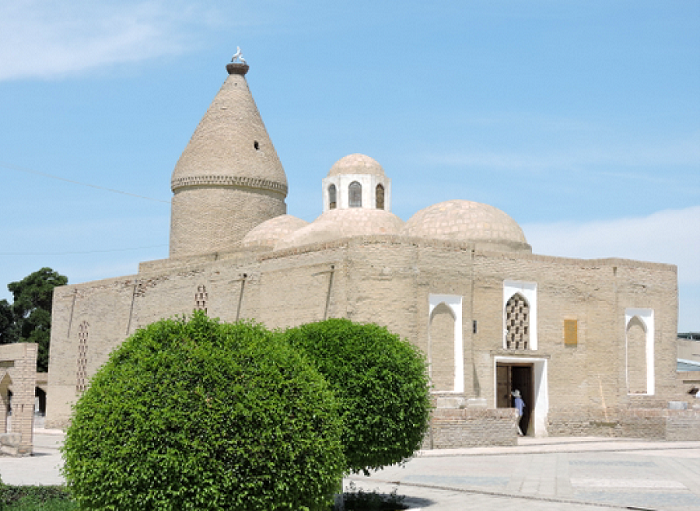 We’re all familiar with the sufferings of Job in the Old Testament’s Book of Job. But what happened to Job after his sufferings were ended? All the OT says is that, with his health and riches restored, he lived long enough to see his great-great grandchildren.
We’re all familiar with the sufferings of Job in the Old Testament’s Book of Job. But what happened to Job after his sufferings were ended? All the OT says is that, with his health and riches restored, he lived long enough to see his great-great grandchildren.
The OT says Job lived in the “Land of Uz,” which was “beyond the Euphrates.” That would place it in modern day Iraq. There is no connection between this Hebraic name and the land of Uzbekistan – meaning the Land of Uzbeks, a Turkic people. Yet the Silk Road city of Bukhara in today’s Uzbekistan is thousands of years old.
Jews have lived in Bukhara for 3,000 years, although almost all have emigrated now (some 150,000 Bukharan Jews live in Israel). Thus it is a very ancient legend that during a terrible drought in Bukhara, Job visited the city and struck the ground with his staff – causing a spring of healing water to gush from the ground, and continues to do so today.
A shrine was built around the spring – the Well of Job – and the water is clear and drinkable. One of the many extraordinary experiences in what we call Hidden Central Asia. We’ll be here again this coming May. (Glimpses of Our Breathtaking World #114 photo ©Jack Wheeler)
THE CAMEL MEAT MARKET IN THE FEZ BAZAAR
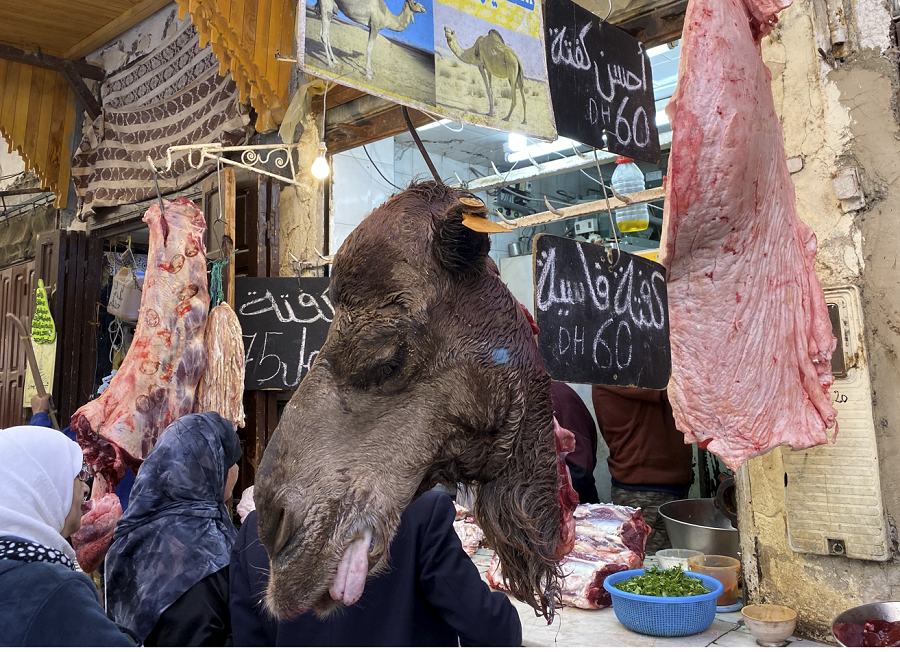 Sometimes you run across something that no matter how it grosses you out, you have to take a picture of it. The thousand year-old medina or walled city of Fez is a World Heritage Site as the spiritual and cultural capital of Morocco. Uniquely epitomizing this is the stall of the camel butcher in the medina’s vast bazaar. To garner the attention of ladies shopping for their family’s dinner, he proudly displays the head of the camel whose fresh meat is on sale. Traveling in Morocco is always an adventure. (Glimpses of Our Breathtaking World #188 photo ©Jack Wheeler)
Sometimes you run across something that no matter how it grosses you out, you have to take a picture of it. The thousand year-old medina or walled city of Fez is a World Heritage Site as the spiritual and cultural capital of Morocco. Uniquely epitomizing this is the stall of the camel butcher in the medina’s vast bazaar. To garner the attention of ladies shopping for their family’s dinner, he proudly displays the head of the camel whose fresh meat is on sale. Traveling in Morocco is always an adventure. (Glimpses of Our Breathtaking World #188 photo ©Jack Wheeler)
BEETHOVEN AND TRUMP
 [This Monday’s Archive was originally published in TTP on November 18, 2016, shortly after Donald Trump won his first stunning victory of the presidency. The Dems succeeded with their theft of the White House in 2020 and did everything they could to ruin our country for four years. That’s over now with Trump back where he belongs, so we can take the message here to heart more than ever.]
[This Monday’s Archive was originally published in TTP on November 18, 2016, shortly after Donald Trump won his first stunning victory of the presidency. The Dems succeeded with their theft of the White House in 2020 and did everything they could to ruin our country for four years. That’s over now with Trump back where he belongs, so we can take the message here to heart more than ever.]
TTP, November 18, 2016
There is no word in the English language for schadenfreude – a German word that translates to “joy in the misfortune of others.”
British writer Alistair Cooke calls schadenfreude "an unworthy emotion, which may be why we don't admit to it by having a word in English."
Yet only saints don’t feel or enjoy schadenfreude. This is particularly so when we feel the misfortune and misery of others is deserved. That’s why audiences cheer when the villain in a movie gets his in the end.
Or how about this news: Oregon Official Who Persecuted Christian Bakers Loses Election. Don’t you feel like shouting, “Hallelujah!”?
That’s why it’s fun to see celebrities and college crybabies going bananas protesting Trump’s landslide victory. They hate America, want to see it ruined, and fully deserve all the heartache and despair they’re feeling.
Right? However…
Even though schadenfreude is fun to feel, we don’t want it to linger in our hearts. The longer it lingers, the more corrosive it is to our souls. Okay, laugh at the losers, but then start feeling something better. What would that be?
Let’s look to Beethoven for the answer.
FLASHBACK FRIDAY: THE HOLE OF SORROWS
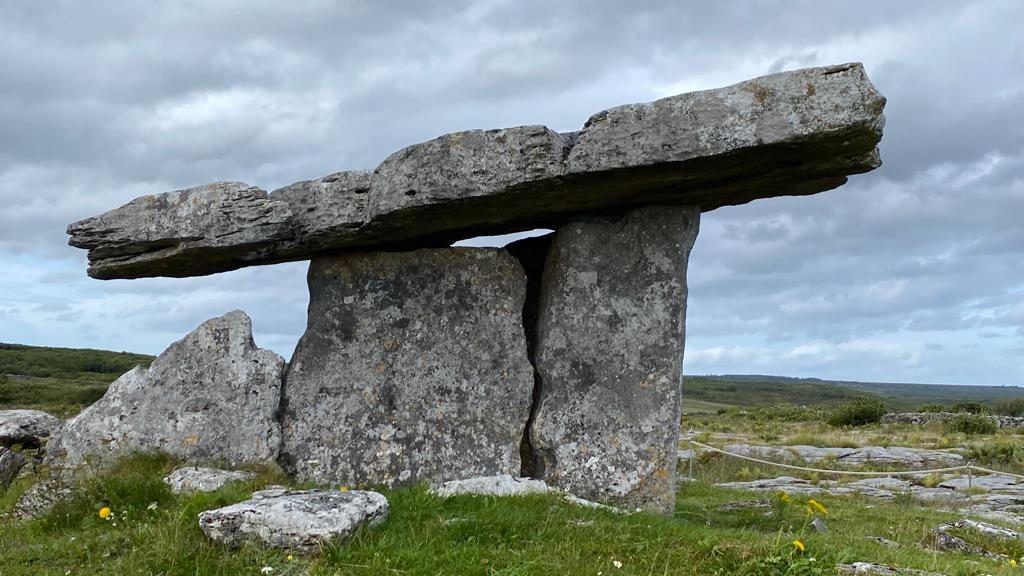 Let’s flashback 2.2 million Fridays to 4,000 BC, six thousand years ago, when the original inhabitants of post-Ice Age Ireland erected this megalithic “dolmen” or portal tomb. It consists of three standing portal stones suspending a massive horizontal capstone, the limestone entrance to a tomb originally covered with an earthen mound.
Let’s flashback 2.2 million Fridays to 4,000 BC, six thousand years ago, when the original inhabitants of post-Ice Age Ireland erected this megalithic “dolmen” or portal tomb. It consists of three standing portal stones suspending a massive horizontal capstone, the limestone entrance to a tomb originally covered with an earthen mound.
Eventually the mound weathered away revealing the stone “skeleton” which was a sacred shrine for the Megalithic Irish all the way to the medieval Celts even though in a remote barren rocky region of far western Ireland found now in County Clare.
When it was finally excavated in 1986, the remains of 33 humans were found in the burial chamber below who lived between 3,800 and 3,200 BC. Thus it became known as “The Hole of Sorrows.”
When you come to gaze upon The Hole of Sorrows, you realize that this massive stone structure, one thousand four hundred years older than Egypt’s Great Pyramid, has stood here for all of recorded human history and beyond. All the kings and empires of all history have come and gone, while it still stands. It’s megalithic creators of millennia ago would be proud. (Glimpses of Our Breathtaking World #219 photo ©Jack Wheeler)
HALF-FULL REPORT 04/18/25
 Welcome to the Good Friday HFR. This is a solemn day – not of celebration for that comes overmorrow on Easter Sunday, but the opportunity for Christians across the world to reflect upon the deep significance of what Christianity means to their lives, and to recommit themselves to it. For TTPers, may you all have a most meaningful Good Friday.
Welcome to the Good Friday HFR. This is a solemn day – not of celebration for that comes overmorrow on Easter Sunday, but the opportunity for Christians across the world to reflect upon the deep significance of what Christianity means to their lives, and to recommit themselves to it. For TTPers, may you all have a most meaningful Good Friday.
I’ve been away from the HFR for a long time – my last HFR was on February 28, and now it’s April 18. There is simply no way I can adequately thank Mike Ryan enough for his six straight HFRs while I was in Africa and Bhutan. Especially since each was so exceptionally profound, phenomenal, even awe-inspiring.
The same goes for the TTP Team – Miko, Mellie, Deuce, Joel, Greg & Michelle – who, along with Mike, made sure TTP remained superlative over the last six weeks. I am so very appreciative to you all.
So here we go – where do we start? Well, how about the Dems picking the absolutely stupidest, most ludicrously counter-productive and self-destructive hill for their party to die on?
THE SACRED MONKEY FOREST OF BALI
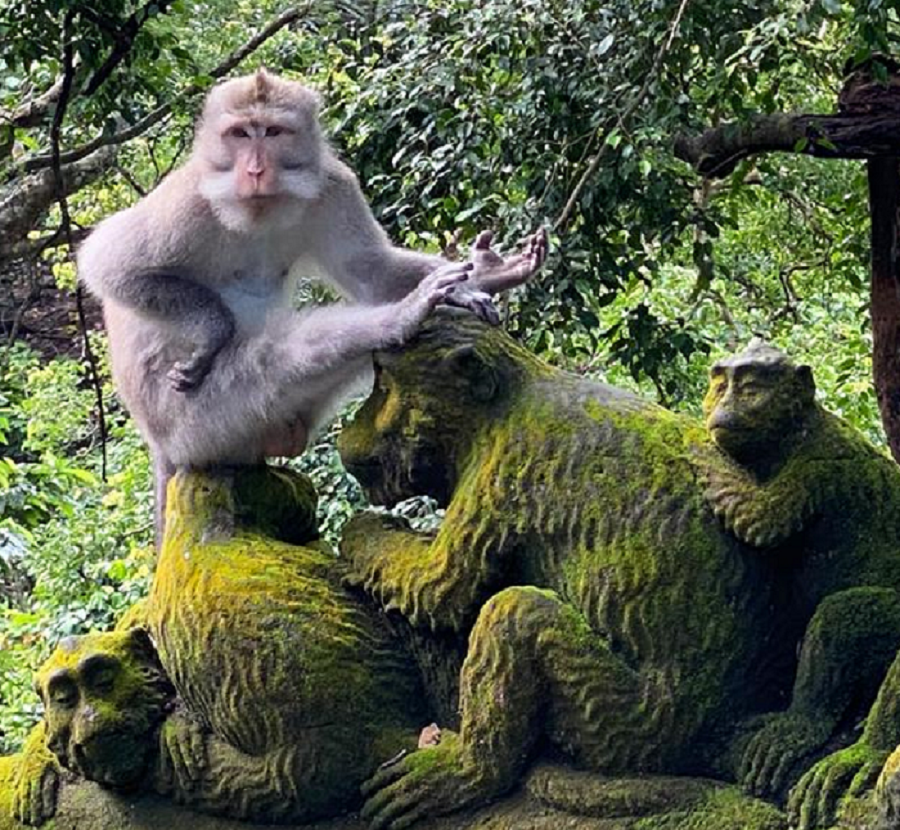 Near the town of Ubud on Indonesia’s paradise island of Bali there is a sanctuary of spectacularly luxuriant rain forest providing a haven for over 1,000 Balinese long-tailed monkeys. Here’s one communing with a group of moss-covered monkey statues that dot the sanctuary.
Near the town of Ubud on Indonesia’s paradise island of Bali there is a sanctuary of spectacularly luxuriant rain forest providing a haven for over 1,000 Balinese long-tailed monkeys. Here’s one communing with a group of moss-covered monkey statues that dot the sanctuary.
This is a sacred place for the Balinese people, as it contains three temples over 600 years old, and is devoted to the Hindu principle of Tri Hata Karana – “three ways to reach spiritual and physical well-being” -- harmony between people, harmony between people and nature, harmony between people and God.
There is perhaps no place on earth in which to better experience the blissful harmony of Tri Hata Karana than Bali. It is a marvelous privilege to be here and experience it for yourself. (Glimpses of Our Breathtaking World #106 photo ©Jack Wheeler)
DARK HEDGES
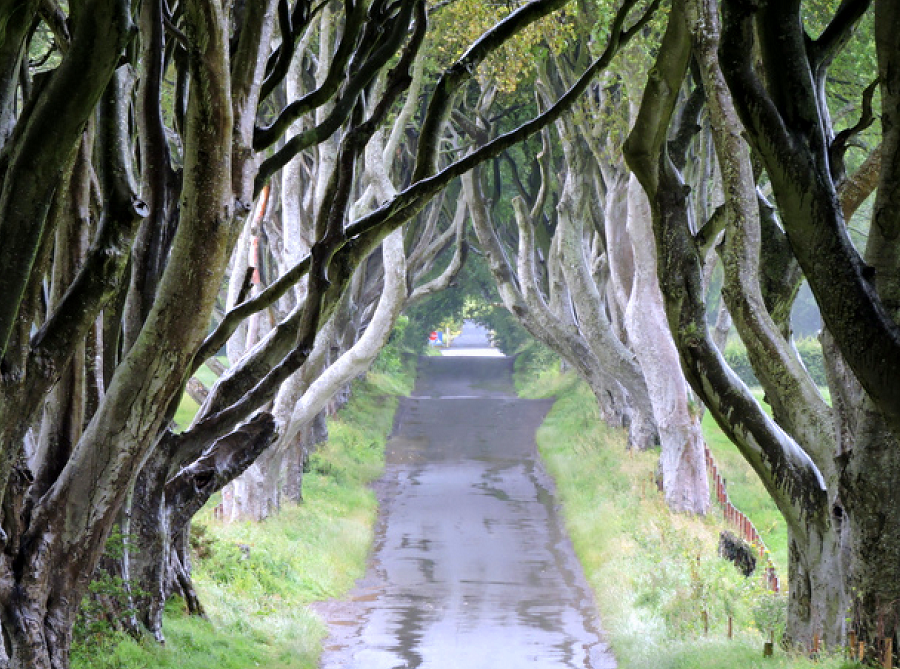 You’ve seen this spooky place called King’s Road in HBO’s The Games of Thrones – but where is it and what is it really? It’s in Country Antrim in Northern Ireland near the town of Armoy. Originally it was the driveway to a mansion built in 1775 by James Stuart, descendant of King James I of England (1566-1625), who lined either side with beech trees. Now almost 250 years old, their branches intertwine eerily, giving rise to its name of “Dark Hedges,” and legends of ghosts haunting it like the “Grey Lady.”
You’ve seen this spooky place called King’s Road in HBO’s The Games of Thrones – but where is it and what is it really? It’s in Country Antrim in Northern Ireland near the town of Armoy. Originally it was the driveway to a mansion built in 1775 by James Stuart, descendant of King James I of England (1566-1625), who lined either side with beech trees. Now almost 250 years old, their branches intertwine eerily, giving rise to its name of “Dark Hedges,” and legends of ghosts haunting it like the “Grey Lady.”
Northern Ireland has had its terrible Troubles as we all know, but that’s history now. It’s a place of stunning scenery and natural wonders like the Devil’s Causeway and Marble Arch Caves, and those man-made in addition to Dark Hedges, such as Dunluce Castle and Carrick-a-Rede Rope Bridge. Then there’s the Victorian opulence of the Crown Liquor Saloon in Belfast. All in all, Northern Ireland is a marvelous place to visit. (Glimpses of Our Breathtaking World #43 photo ©Jack Wheeler)
TANTRIC BHUTAN
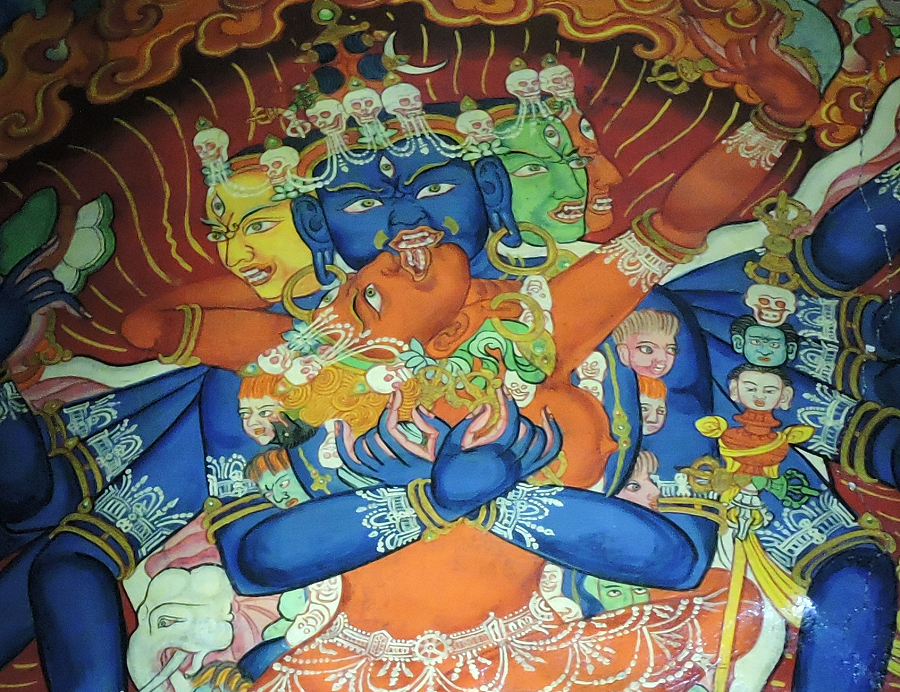 The most fabulously exotic country on earth is the Himalayan Kingdom of Bhutan. The Bhutanese religion of Tantric Buddhism is here exemplified by a prayer hall wall painting of Yab-Yum – the physical union of Compassion and Wisdom. Male compassion is personified as the deity Samvara with a blue body, multiple faces and arms. He embraces his consort of female wisdom Vajra-varahi.
The most fabulously exotic country on earth is the Himalayan Kingdom of Bhutan. The Bhutanese religion of Tantric Buddhism is here exemplified by a prayer hall wall painting of Yab-Yum – the physical union of Compassion and Wisdom. Male compassion is personified as the deity Samvara with a blue body, multiple faces and arms. He embraces his consort of female wisdom Vajra-varahi.
It is important to understand that Yab-Yum is considered a sacred act as a path to Enlightenment. It is just one example of how Bhutan may stretch our comfort zone to learn ancient ways and practices, giving us a broader perspective on our humanity. For an in-depth understanding of Bhutan’s extraordinary culture, consider joining our Wheeler-Windsor Expedition to the Land of the Thunder Dragon next year. (Glimpses of Our Breathtaking World #16 photo ©Jack Wheeler)
INSIDE GIBRALTAR
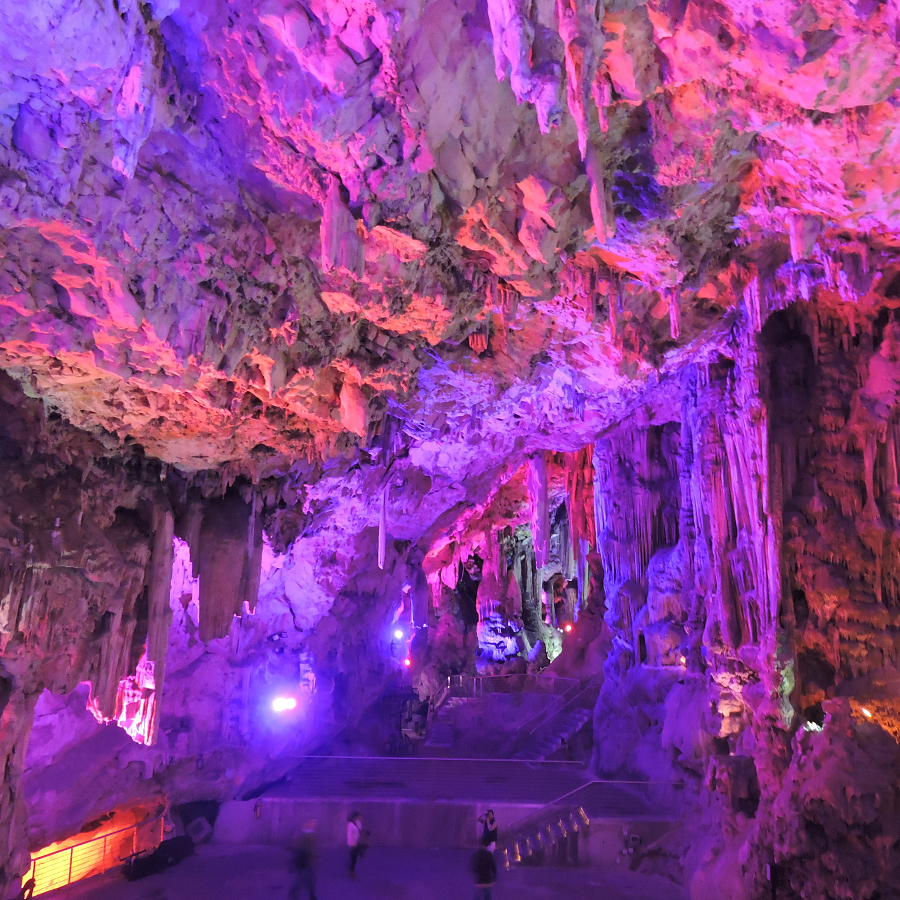 We’re all familiar with the famed Rock of Gibraltar, huge and imposing from the outside – but inside the Rock itself is the enormous St. Michael’s Cave with fantastical formations colorfully illuminated.
We’re all familiar with the famed Rock of Gibraltar, huge and imposing from the outside – but inside the Rock itself is the enormous St. Michael’s Cave with fantastical formations colorfully illuminated.
For millions of years, rainwater created fissures in the Rock’s limestone widening into huge caves with the steady drip of mineralized water creating massive stalactites hanging from cave ceilings and stalagmites rising up from cave floors. A phantasmagorical experience.
Gibraltar has been a British territory since 1713 when Spain ceded it in the Treaty of Utrecht. Thus also high up inside the Rock are the Great Siege Tunnels the British dug then lined with cannon emplacements to defeat Spain’s attempt to seize Gibraltar in the 1780s.
Walking through the tunnels, you peer below looking down where the Spaniards and their French allies were vainly dug in – and where there is now an airplane runway stretching across the isthmus.
That’s just a glimpse of what to discover visiting Gibraltar, as there’s so much more! (Glimpses of Our Breathtaking World #12, photo ©Jack Wheeler)
THE MOONLIGHT SYMPHONY
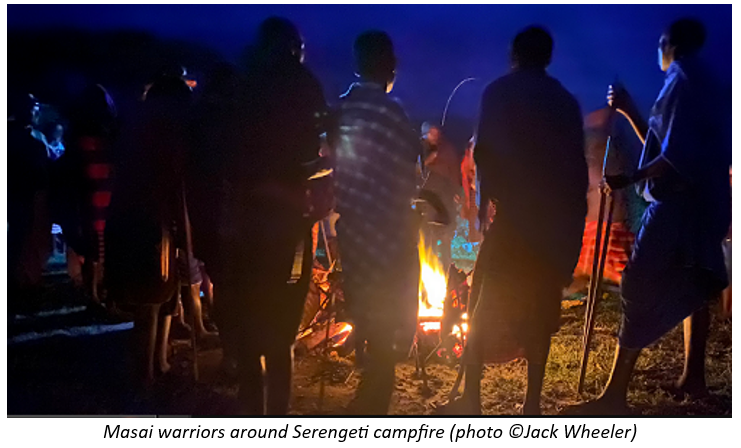 [This Monday’s Archive was first published on July 1, 2005. It has particular relevance today, as you’ll soon see. As you know, I just returned from our latest safari in the Serengeti. So I was taken aback on how what was written on safari in Africa 20 years ago applies to America right now. The big difference is that today we have a President who behaves more like a Masai than his last several predecessors]
[This Monday’s Archive was first published on July 1, 2005. It has particular relevance today, as you’ll soon see. As you know, I just returned from our latest safari in the Serengeti. So I was taken aback on how what was written on safari in Africa 20 years ago applies to America right now. The big difference is that today we have a President who behaves more like a Masai than his last several predecessors]
TTP, July 1, 2005
MORU ROCKS, SERENGETI PLAINS, TANZANIA, AFRICA. It is at night that Africa becomes most alive – especially when there’s a full moon.
The most restful night’s sleep one can have, it seems, is when you are lulled by the cackling whine of hyenas, the incessant barking of zebras, the coughing of lions, the grunting of hippos, the bellowing of Cape buffalo, the stomach rumblings of elephants, the flutter of Guinea fowl roosting in the trees, and the soft chirp of the tiny Scopes owl. The Moonlight Symphony of the Serengeti.
It is so soothing, perhaps, because these sounds accompanied our emergence upon this earth. The plains of East Africa are where such proto-hominids as Australopithicus and Homo habilis became us, human beings. It is where we came out of the trees, onto the plains, and became predators.
The dominant life form on these plains is mammals, and as you witness their vast numbers divided into a myriad of different species, you see there are two kinds: predators and prey. One way to distinguish between the two is the eyes.
FLASHBACK FRIDAY – SHACKLETON
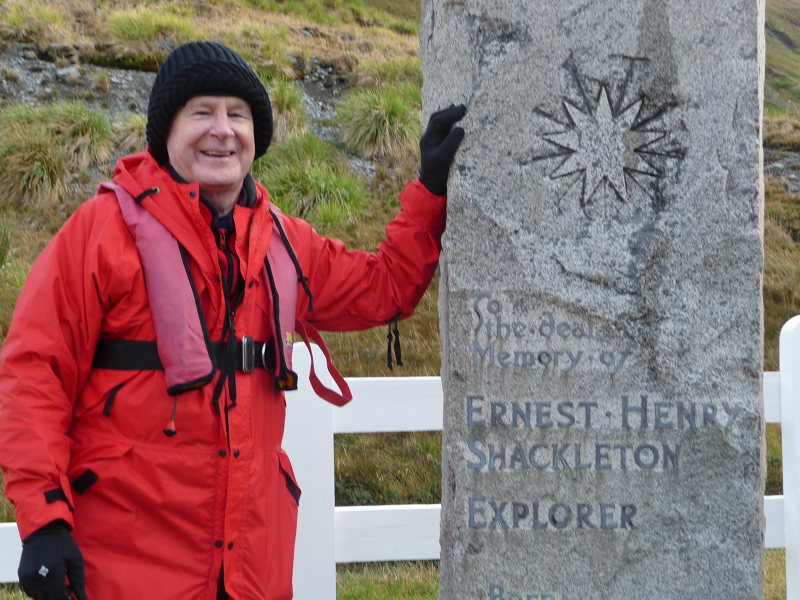 You likely read the new story this week of the extraordinary discovery of Antarctic legendary explorer Ernest Shackleton’s ship The Endurance 10,000 feet deep at the bottom of the Weddell Sea: Ernest Shackleton’s Sunken Ship Endurance Found 107 Years Later (3/09/22).
You likely read the new story this week of the extraordinary discovery of Antarctic legendary explorer Ernest Shackleton’s ship The Endurance 10,000 feet deep at the bottom of the Weddell Sea: Ernest Shackleton’s Sunken Ship Endurance Found 107 Years Later (3/09/22).
Perhaps you read my account of his incredible exploits in Endurance (April 2013). I thought to commemorate the ship’s discovery with this photo of me at Shackleton’s gravesite at the abandoned whaling station of Grytviken on the Antarctic island of South Georgia.
Shackleton was the most heroic arctic explorer of them all. The famous eulogy at his funeral says it all:
For scientific discovery, give me Scott
For speed and efficiency of travel, give me Amundsen
But when disaster strikes and all hope is gone
Get down on your knees and pray for Shackleton
(Glimpses of Our Breathtaking World #192 photo ©Jack Wheeler)SLOVENIA’S VINTGAR GORGE
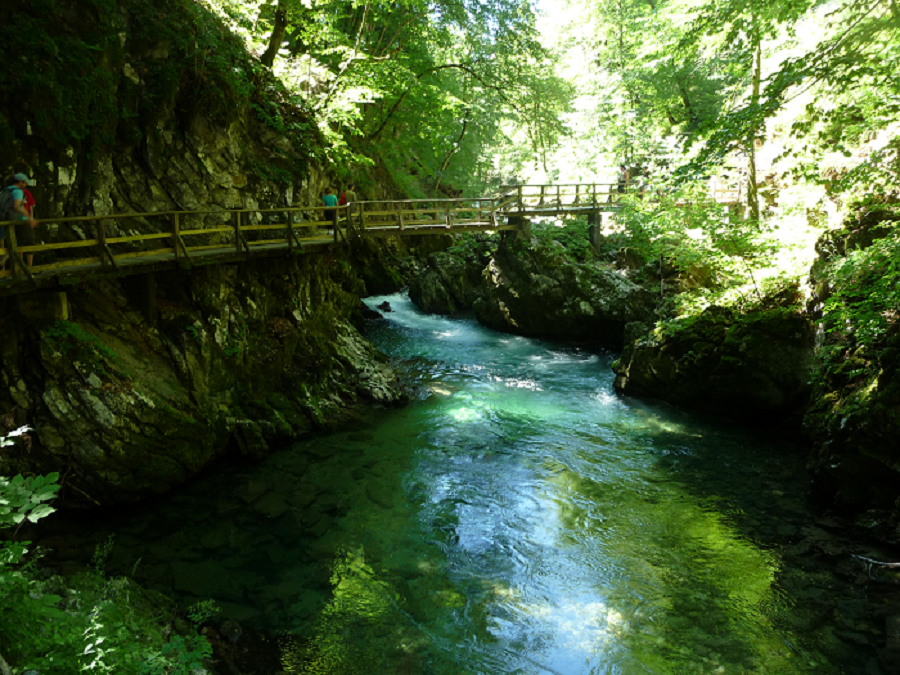 In a hidden corner of Europe, the Radovna River pours off the Julian Alps to carve out the Vintgar Gorge with crystal clear water. A mile-long walkway with towering limestone cliffs on either side is your access.
In a hidden corner of Europe, the Radovna River pours off the Julian Alps to carve out the Vintgar Gorge with crystal clear water. A mile-long walkway with towering limestone cliffs on either side is your access.
Nearby is the gorgeous Lake Bled, with Bled Castle suspended atop a shoreline cliff. The medieval village of Piran, built on a spit of land projecting into the Adriatic Sea and encircled by a white sand beach is a short drive away. Ljubljana is one of Europe’s most utterly charming capital cities.
Most people have only heard of Slovenia as the birthplace of First Lady Melania Trump, but those who have been here understand it is one of the most entrancing countries on the European continent – pristine beauty, spotless environment, friendly and hospitable people, safe and very well-run. Whenever your next visit to Europe may be, try to include a few days or week or so here. You’ll never run out of fascinating things to do. A stroll through the Vintgar Gorge is an example out of so many. (Glimpses of Our Breathtaking World #19 photo ©Jack Wheeler)
ROME IN AFRICA
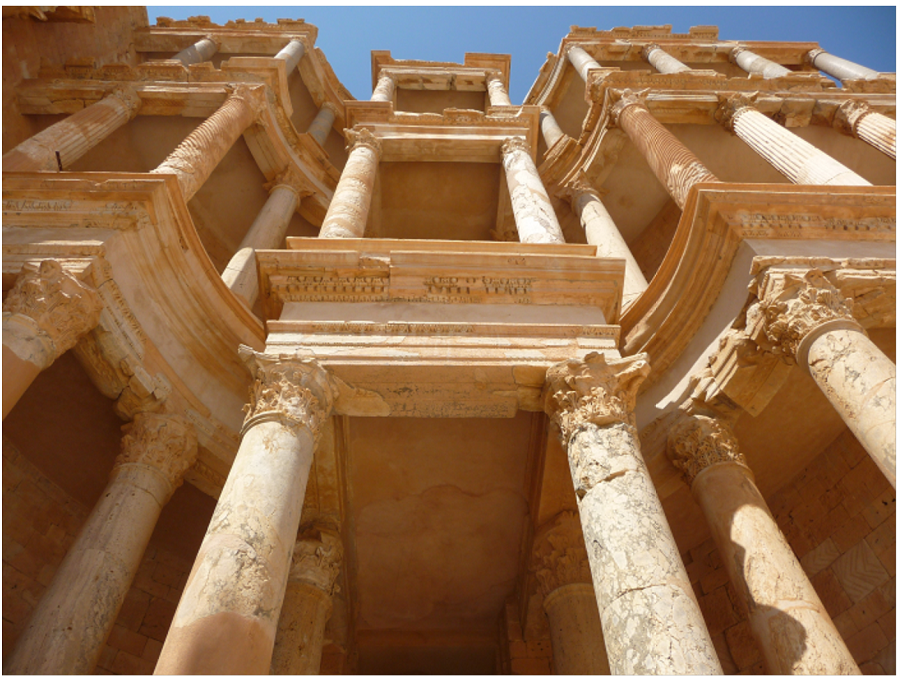 The best place to see Roman ruins is not in Rome or anywhere in Italy. It’s in Africa – specifically on the Mediterranean coast of Libya. This is the Roman theatre at Sabratha built in the 1st century BC. Over 2,000 years old, it’s still mostly intact. Starting as a Berber village, the Phoenicians founded the city as Sabrat by 500 BC. Then came the Greeks, then the Carthaginians, and after the Punic Wars came Rome.
The best place to see Roman ruins is not in Rome or anywhere in Italy. It’s in Africa – specifically on the Mediterranean coast of Libya. This is the Roman theatre at Sabratha built in the 1st century BC. Over 2,000 years old, it’s still mostly intact. Starting as a Berber village, the Phoenicians founded the city as Sabrat by 500 BC. Then came the Greeks, then the Carthaginians, and after the Punic Wars came Rome.
The Libyan coast was a lush fertile place back then. So much so that Sabratha and the other major Roman city nearby, Leptis Magna, produced several million pounds of olive oil per year – sale of which to Rome enabled them to achieve great wealth. It’s a shame that Libya remains today in chaotic civil war. Hopefully the day is not off when experiencing Rome’s most magnificent remains will be possible here again. (Glimpses of Our Breathtaking World #79 photo ©Jack Wheeler)
THE ROCK OF ZANZIBAR
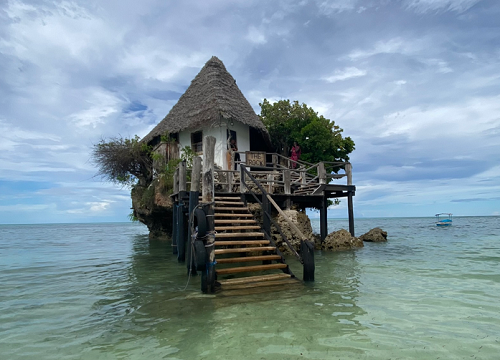 It would be hard to find a more exotic restaurant than The Rock, perched on a coral outcropping off Michanwi Pingwe beach on the east coast of Zanzibar in the Indian Ocean. Start off with what I found to be the world’s best (and largest) piña colada, then tuck in to marvelous fresh caught grilled lobster along with an excellent French chardonnay. Finish with coconut tiramisù and a large cup of great Tanzanian coffee. Rebel and I will always fondly remember our experience here – and so will you should you ever visit the extraordinary island of Zanzibar. (Glimpses of Our Breathtaking World #287, photo ©Jack Wheeler)
It would be hard to find a more exotic restaurant than The Rock, perched on a coral outcropping off Michanwi Pingwe beach on the east coast of Zanzibar in the Indian Ocean. Start off with what I found to be the world’s best (and largest) piña colada, then tuck in to marvelous fresh caught grilled lobster along with an excellent French chardonnay. Finish with coconut tiramisù and a large cup of great Tanzanian coffee. Rebel and I will always fondly remember our experience here – and so will you should you ever visit the extraordinary island of Zanzibar. (Glimpses of Our Breathtaking World #287, photo ©Jack Wheeler)
A MONSTER’S CASTLE
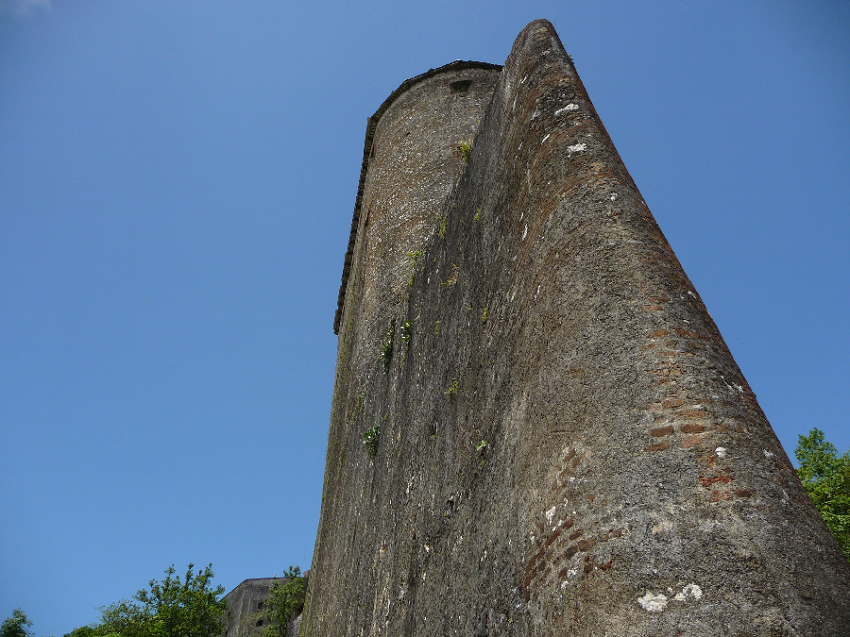 Cap Haitien, Haiti. On a steep mountain top three thousand feet high above the north coast of Haiti, stands this staggeringly gigantic fortress.
Cap Haitien, Haiti. On a steep mountain top three thousand feet high above the north coast of Haiti, stands this staggeringly gigantic fortress.
It is the Citadelle Laferrière, revered by professional distortionists of history as "the greatest monument to black freedom in the Americas." What it really is instead is a monument to totalitarian insanity.
In 1807, the leader of a victorious slave army against the French named Henri Christophe (1767-1820) seized Haiti and proceeded to re-enslave his people. With their slave labor, he built La Citadelle – 20,000 slaves died under the lash or from utter exhaustion building it, hauling hundreds of cannons, tens of thousands of cannon balls, and millions of bricks and rocks 3,000 feet up the steep slopes to the site.
Finally, in 1820, Christophe’s slaves rebelled, his body dissolved in a huge vat of liquid lime, the mortar for the fortress’ bricks. The Citadelle has been a deserted ruins ever since. I was the only visitor there. So much for "the monument to black freedom." Haiti has never experienced a single day of freedom in its entire existence to this very day.
Haiti, in other words, is not only a failed state – for over 200 years, it has always been a failed state. Tragically, the odds are high it always will be. (Glimpses of Our Breathtaking World #265 photo ©Jack Wheeler)
PRAYERS
Prayer ceremony at Tibetan Buddhist monastery in Bhutan, monks praying for Jack’s recovery
Thimphu, capital of the Himalayan Kingdom of Bhutan. The room service waiter upon delivery told my wife Rebel, “I want to meet Jack.” I’d been bedridden here for several days diagnosed with pneumonia. He wanted to meet the American being cared for every morning and evening by the doctor of the King and Queen. He had never heard of such a thing.I evidently contracted it on the plane from Istanbul to Bangkok to connect to here by a woman sitting near me with this constant terrible cough she wouldn’t do anything about. Thank heavens Rebel was unaffected. If you have adult-onset asthma like I do, getting pneumonia is really not good. That’s compounded by the altitude of Thimphu at 8,200 feet. Oh, then add in the thick smoke from forest fires nearby blanketing the air.
So I ended up in the hospital where after a battery of tests, my pneumonia was confirmed and was told recovery would take two weeks. I messaged Miko, and was soon told the entire TTP Team – Mellie, Mike Ryan, Mark Deuce, Joel Wade, Greg Pryor – were praying for me daily. Miko’s Mom had her prayer group in Manila praying for me every day.
FLASHBACK FRIDAY: A DAZZLE OF ZEBRAS
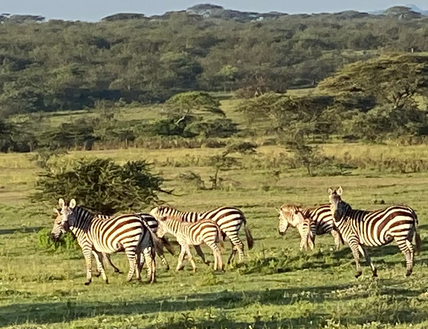 Groups of animals have collective nouns, like a pride of lions or a school of fish. A group of zebras is called a dazzle. The term is excellently appropriate. You may wonder why zebras have such clearly obvious stripes that any predator can see. The reason is that predators like lions or hyenas always target a specific individual in the group that’s weak, young or vulnerable. To be dazzled is to be confused or bewildered, and that’s just what zebra stripes do to attacking predators. As the zebras merge on the run, it’s far more difficult for the predator keep focused on the selected target – so the zebras escape unscathed far more often than not. Their stripes are a marvel of evolutionary survival. This photo was taken on the plains of the Serengeti and we just finished visiting it last week. (Glimpses of Our Breathtaking World #285, photo ©Jack Wheeler)
Groups of animals have collective nouns, like a pride of lions or a school of fish. A group of zebras is called a dazzle. The term is excellently appropriate. You may wonder why zebras have such clearly obvious stripes that any predator can see. The reason is that predators like lions or hyenas always target a specific individual in the group that’s weak, young or vulnerable. To be dazzled is to be confused or bewildered, and that’s just what zebra stripes do to attacking predators. As the zebras merge on the run, it’s far more difficult for the predator keep focused on the selected target – so the zebras escape unscathed far more often than not. Their stripes are a marvel of evolutionary survival. This photo was taken on the plains of the Serengeti and we just finished visiting it last week. (Glimpses of Our Breathtaking World #285, photo ©Jack Wheeler)
THE SACRED LAKE OF PHOKSUNDO
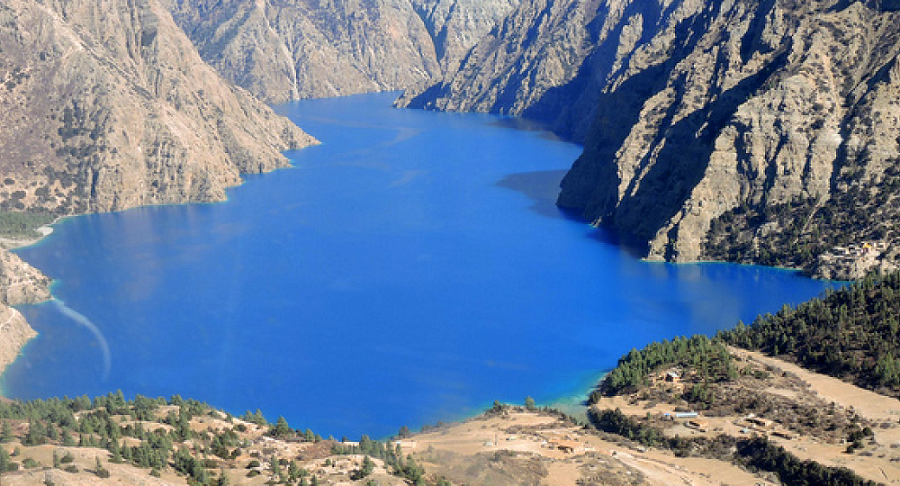 West of the Himalayan giants of Annapurna and Dhaulagiri in Nepal lies a roadless high wilderness inhabited only by Tibetan nomads called Dolpa. The region is named after them, Dolpo. The Dolpa practice the ancient pre-Buddhist animist religion of Tibet called Bön. They worship sites of nature they consider holy. And holiest of all is the Sacred Lake of Phoksundo.
West of the Himalayan giants of Annapurna and Dhaulagiri in Nepal lies a roadless high wilderness inhabited only by Tibetan nomads called Dolpa. The region is named after them, Dolpo. The Dolpa practice the ancient pre-Buddhist animist religion of Tibet called Bön. They worship sites of nature they consider holy. And holiest of all is the Sacred Lake of Phoksundo.
The Dolpa consider the blue of Phoksundo an act of magic by the gods. Once you see it, you can only agree. This picture is not photoshopped – it is real. We always visit it in late October when it is ice free on our Himalaya Helicopter Expeditions. (Glimpses of Our Breathtaking World #41 Photo ©Jack Wheeler)
THE IDEAL ESCAPE HATCH
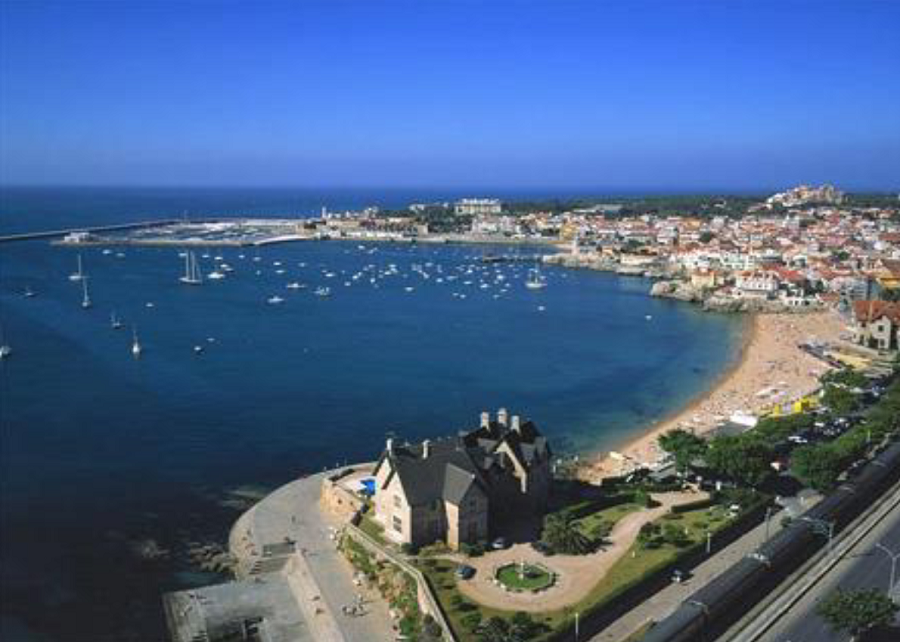 What would be an ideal place to escape from all the lunacy washing over our country – for a few days to a second home?
What would be an ideal place to escape from all the lunacy washing over our country – for a few days to a second home?
Let’s see… it would have to be a First World country with all the civilized amenities of modern life, and a cultured, educated, and welcoming people many, many of whom speak English.
A First World country that brushes aside all Woke nuttiness engulfing the US as silly rubbish to be ignored, and traditional Christian family values revered instead. That is not much farther away than a US cross-country flight. That has Goldilocks weather, not too hot, not too cold. That has sunsets in the ocean, fabulous food and wine, incredible castles in the sky, history that’s thousands of years old yet so hip and current it’s the cultural capital of its continent.
We’ve had Glimpses of this place before: The Europe That’s Still There, and The Portuguese Riviera. Yes, the Ideal Escape Hatch for us is Portugal – a quick overnight flight getting there, a morning flight return.
For 10 days in October of 2022, Rebel and I conducted a Portugal Exploration for TTPers. Rebel and I and your fellow TTPers will be doing it again next month. Just click on Portugal Exploration – May 2 -11, 2025 -- you owe it to yourself to be entranced by the photos, for a glimpse of this ideal place. (Glimpses of our Breathtaking World #157 ©photo Jack Wheeler)
ALBANIA’S BLUE EYE
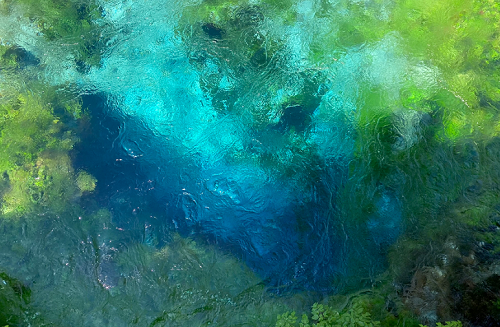 This is not a Monet painting. It is a real photograph looking straight down upon the swirling clear blue water of the Syri i Kaltër – Blue Eye – Spring burbling up from a deep karst hole of the Bistricë River in the mountains of southern Albania.
This is not a Monet painting. It is a real photograph looking straight down upon the swirling clear blue water of the Syri i Kaltër – Blue Eye – Spring burbling up from a deep karst hole of the Bistricë River in the mountains of southern Albania.
The water surges up with such force that scuba divers trying to determine the spring’s depth could only get down to 50 meters (164ft) and no more, thus the depth of the underwater source is unknown. The water is cristal clear, drinkably pure, and very cold. Found between the World Heritage mountain town of Gjirokaster and the Adriatic beach resort town of Saranda, it’s a hypnotic, mesmerizing experience. The Blue Eye is the beauty of nature at its most entrancing. (Glimpses of Our Breathtaking World #293, photo ©Jack Wheeler)
THE SULTAN ASTRONOMER
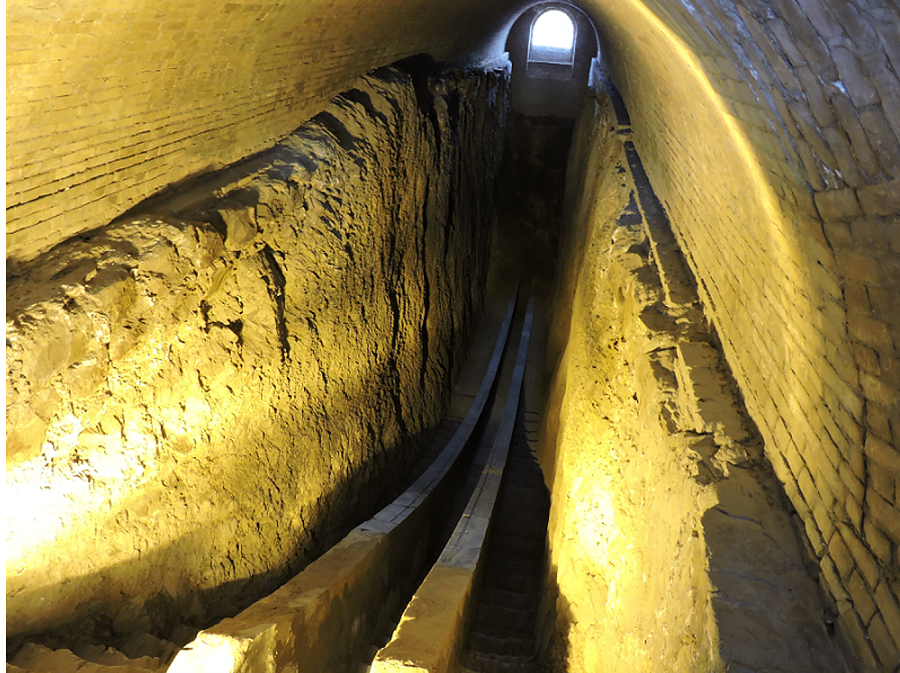 You’re looking at something historically and scientifically astonishing. It is what remains of an astronomical observatory built 600 years ago – in 1420 – by a Sultan in Central Asia who loved science and mathematics more than war and conquest.
You’re looking at something historically and scientifically astonishing. It is what remains of an astronomical observatory built 600 years ago – in 1420 – by a Sultan in Central Asia who loved science and mathematics more than war and conquest.
It was in Samarkand, the most fabled oasis of the Silk Road, that Sultan Ulugh Beg built his circular observatory, three stories high of white marble. All that’s left today is part of the underground sextant that you see in the photo.
For the full story of what he achieved, with many more photos, click on The Sultan Astronomer in TTP I wrote in 2020.
This Glimpse is to whet your appetite to learn about this amazing Sultan and his scientific achievements.
It’s also to whet your appetite for joining your fellow TTPers on our Heart of Central Asia expedition this September. The story of The Sultan Astronomer is but one example of what awaits you in exploring Central Asia, an enrichment of your life beyond description. (Glimpses of Our Breathtaking World #212 photo ©Jack Wheeler)
THE ALLAH THAT FAILED
 [This Monday’s Archive was originally published on January 6, 2004. Facts are slippery things, especially when they are inconvenient. Ibn Warraq continues to speak out and publish the inconvenient truths of Islam under his pen name (which means “son of a papermaker”). It is a name that dissident authors have used throughout the history of Islam, who hide in fear for their lives. In 2007 Douglas Murray described Ibn Warraq as one who “refuses to accept the idea that all cultures are equal. Were Ibn Warraq to live in Pakistan or Saudi Arabia, he would not be able to write. Or if he did, he would not be allowed to live.” The culture of Allah is a culture of death.]
[This Monday’s Archive was originally published on January 6, 2004. Facts are slippery things, especially when they are inconvenient. Ibn Warraq continues to speak out and publish the inconvenient truths of Islam under his pen name (which means “son of a papermaker”). It is a name that dissident authors have used throughout the history of Islam, who hide in fear for their lives. In 2007 Douglas Murray described Ibn Warraq as one who “refuses to accept the idea that all cultures are equal. Were Ibn Warraq to live in Pakistan or Saudi Arabia, he would not be able to write. Or if he did, he would not be allowed to live.” The culture of Allah is a culture of death.]
Let’s say there’s this fellow named Moe. He makes a living as a highway bandit robbing travelers. Any victim who gives him any trouble he kills. Moe has a special hatred for Jews. “Kill Jews wherever you find them,” he tells the members of his gang.
At age fifty, Moe tells his best friend that he’s fallen in love with his daughter and wants to marry her. She is six years old. They are “married” and Moe starts having sex with the little girl when she is nine years old.
Moe tells his gang that God talks to him. As the Messenger of God, every word of Moe’s is the Word of God. Moe has his gang members kill anyone who refuses to believe this.
Here’s the question: Is Moe a criminally insane pervert and moral monster, or is he worshipped by hundreds of millions of devout followers who deeply believe that he is the most moral human being who ever lived?
The answer is: he is both.
FLASHBACK FRIDAY – THE CRUSADER FORTRESS IN THE CAUCASUS
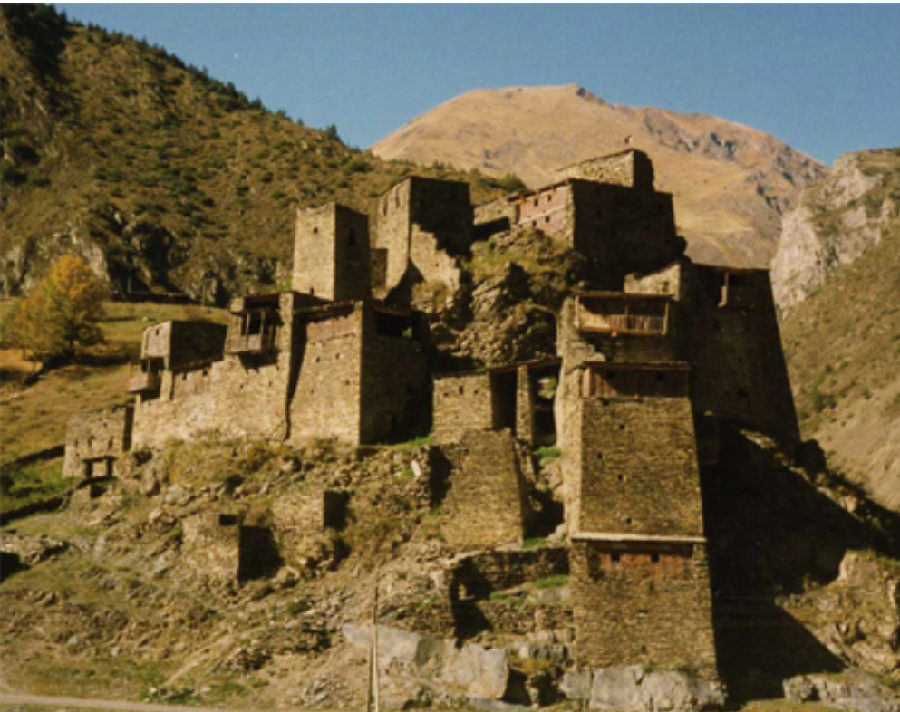 This is the fortress town of Shatili in an extremely remote Caucasus region in Georgia called Khevsureti. It was built by the Crusaders 1,000 years ago. The Khevsur people who live here trace their ancestry back to these Crusaders and until the 1930s still wore chain mail in feud-battles with other towns. I took this picture in 1991.
This is the fortress town of Shatili in an extremely remote Caucasus region in Georgia called Khevsureti. It was built by the Crusaders 1,000 years ago. The Khevsur people who live here trace their ancestry back to these Crusaders and until the 1930s still wore chain mail in feud-battles with other towns. I took this picture in 1991.
American traveler Richard Halliburton (1900–1939) saw and recorded the customs of the Khevsurs in 1935. The Khevsur men, dressed in chain mail and armed with broadswords, wore garments full of decoration made up of crosses and icons. They don’t do that anymore, but they proudly retain their Crusader Christian heritage – for Georgia adopted Christianity in the 4th century AD. (Glimpses of Our Breathtaking World #85 photo ©Jack Wheeler)
THE REGISTAN OF SAMARKAND
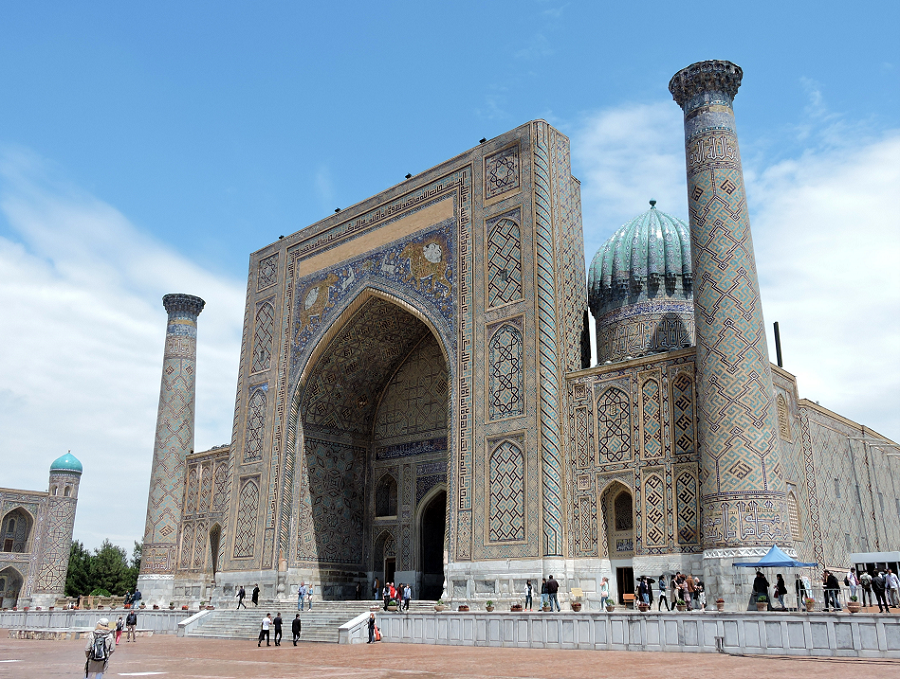 The magnificent Sher-Dor Madrassa, built in the early 1600s, is part of the Registan public square complex of the ancient Silk Road oasis of Samarkand. What’s fascinating is the mosaic depiction of living beings on either side of the arch – a tiger and on its back a rising sun deity with a human face. This is honoring the pre-Islamic history of Samarkand that goes back almost 3,000 years.
The magnificent Sher-Dor Madrassa, built in the early 1600s, is part of the Registan public square complex of the ancient Silk Road oasis of Samarkand. What’s fascinating is the mosaic depiction of living beings on either side of the arch – a tiger and on its back a rising sun deity with a human face. This is honoring the pre-Islamic history of Samarkand that goes back almost 3,000 years.
It was centuries old when Alexander conquered it in 329 BC. For a thousand years as Central Asia’s great entrepot on the Silk Road between China and the Mediterranean, it was a cosmopolitan center for Hinduism, Buddhism, Judaism, Zoroastrianism, and Nestorian Christianity. Incorporated into the Islamic world in the 700s, sacked by Genghiz Khan in 1220, rebuilt by the time Marco Polo in 1272 described it as “a large and splendid city,” Tamerlane made it his capital in 1370.
Colonized by Czar Alexander II in the 1860s within the Russian Imperial Empire, and by the Soviets in the 1920s within the Uzbek SSR, Samarkand is flourishing today in independent Uzbekistan. There is so much to learn and contemplate upon when you are here. (Glimpses of Our Breathtaking World #67 photo ©Jack Wheeler)
THE MAGIC OF MADEIRA
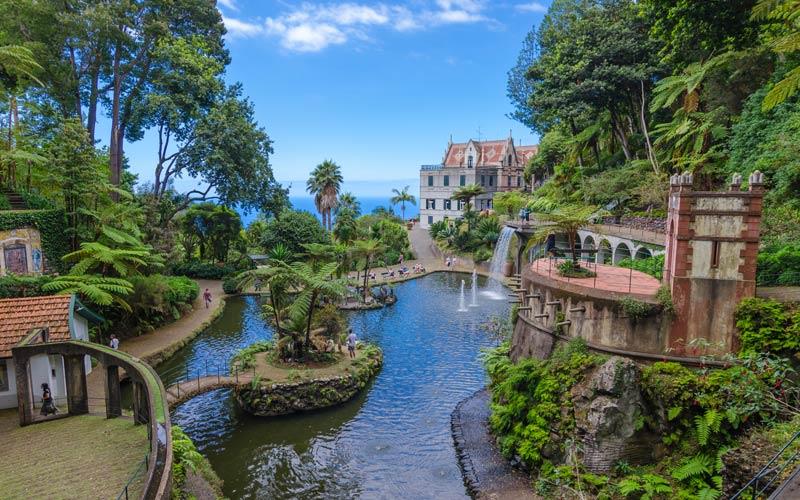 The island of Madeira in the Atlantic some 320 miles west of Morocco was first discovered, uninhabited, by Portuguese explorers in 1418. It has been a part of Portugal ever since. In the 1600s it became renowned for its Madeira wine, with English wine makers settling there and exporting it to England and the American colonies. The English consul Charles Murray built a beautiful estate, “Quinta do Prazer”, Pleasure Estate, high above the capital of Funchal, which by the late 1800s was converted into the Monte Palace hotel.
The island of Madeira in the Atlantic some 320 miles west of Morocco was first discovered, uninhabited, by Portuguese explorers in 1418. It has been a part of Portugal ever since. In the 1600s it became renowned for its Madeira wine, with English wine makers settling there and exporting it to England and the American colonies. The English consul Charles Murray built a beautiful estate, “Quinta do Prazer”, Pleasure Estate, high above the capital of Funchal, which by the late 1800s was converted into the Monte Palace hotel.
100 years later, Portuguese entrepreneurs developed the property into one of the most spectacular tropical gardens in the world, with lakes, waterfalls, and exotic tropical plants turning it into a fantasy wonderland. You can spend hours wandering around relaxing and luxuriating in this peaceful paradise. It’s just one of the magically beautiful places and truly relaxing, energizing experiences we have on Madeira and the Azores. Join your fellow TTPers when we plan our next Atlantic Paradises exploration to enjoy them. Life goes by so quickly, Carpe diem! (Glimpses of Our Breathtaking World #243 photo ©Jack Wheeler)
LOOKING INTO A BABY LEOPARD’S EYES
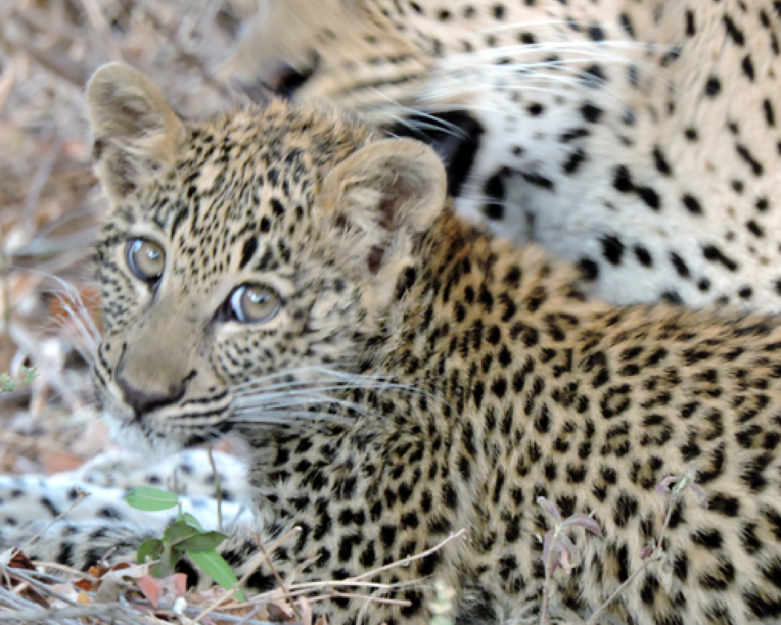 There are not many places in Africa where you can do this, where a leopard mother has no fear of your getting this close to her cub. The best place in all Africa is a region of Zambia called South Luangwa, where iconic African wildlife is in vast profusion yet uninhabited by people. And where you can stay in a safari lodge so luxurious it’s hard to believe you’re way out deep in the African bush.
There are not many places in Africa where you can do this, where a leopard mother has no fear of your getting this close to her cub. The best place in all Africa is a region of Zambia called South Luangwa, where iconic African wildlife is in vast profusion yet uninhabited by people. And where you can stay in a safari lodge so luxurious it’s hard to believe you’re way out deep in the African bush.
I’ve been traveling to Africa for 50 years now – since 1971 – and have been to every country on the continent, so I know how unique a South Luangwa safari is. If you have a dream of experiencing an African safari once in your life, you might consider here. I can hardly wait to come here again. Care to join me, to look into a baby leopard’s eyes yourself? (Glimpses of Our Breathtaking World #117 Photo ©Jack Wheeler)
THE INSPIRATION OF AMERICA
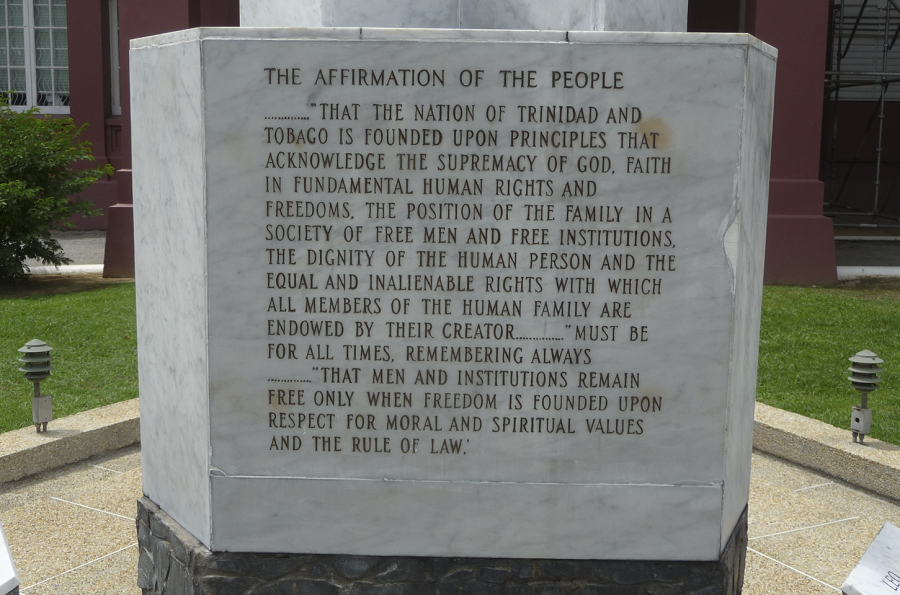 Next to the entrance of The Red House, the Parliament of Trinidad and Tobago in the capital of Port of Spain, there is this marble inscription. It is clear that it is inspired by our 1776 Declaration of Independence and America’s founding principles. Trinidad’s population is 99% either Indian (from India), African, or a mix of the two. 64% are Christian, 21% Hindu, 6% Moslem, others undeclared – and all have these principles as a common bond between them.
Next to the entrance of The Red House, the Parliament of Trinidad and Tobago in the capital of Port of Spain, there is this marble inscription. It is clear that it is inspired by our 1776 Declaration of Independence and America’s founding principles. Trinidad’s population is 99% either Indian (from India), African, or a mix of the two. 64% are Christian, 21% Hindu, 6% Moslem, others undeclared – and all have these principles as a common bond between them.
Here in the Caribbean’s Trinidad is such a clear example of how America’s founding moral principles are such an inspiration to all humanity, of all cultures, creeds, and ethnicities. They are universal, America’s heritage as a gift to the world. This is the heritage of all Americans – something we need to hold on to and hold dear as we persevere during this current period of our country’s cultural, moral, and political lunacy. (Glimpses of Our Breathtaking World #152, photo ©Jack Wheeler)
THE TYRANNY OF CHINA’S HISTORY
[This Monday’s archive was originally published on December 1, 2004 – While the news is fixated on Europe and the Middle East these days, China is always the threat looming in the background. The old saying comes to mind: The more things change, the more they stay the same. This is peculiarly true for China.]
![]() Chinese, written and spoken, is my candidate for the weirdest major language on earth. At the Monterey Institute, where US diplomats are taught foreign languages, it takes on average 600 hours of instruction to be fluent in a European language such as French or German, 1200 for Arabic - and 2400 in Chinese. (This means, of course, that for China and the world to communicate, Chinese must speak English, as the world will never speak Chinese).
Chinese, written and spoken, is my candidate for the weirdest major language on earth. At the Monterey Institute, where US diplomats are taught foreign languages, it takes on average 600 hours of instruction to be fluent in a European language such as French or German, 1200 for Arabic - and 2400 in Chinese. (This means, of course, that for China and the world to communicate, Chinese must speak English, as the world will never speak Chinese).
Beyond the technical difficulties lie far deeper problems, resulting in a grossly myopic view of China’s history and future. The one buried most deeply is the way Chinese grammar reverses time: the past, in Chinese, is in front of or before you, while the future is behind you. Chinese culture is oriented towards the past, reading Chinese history through a distorted lens, and stubbornly attempting to apply illusory lessons to the present.
This is precisely what China’s military and government leaders are doing with their strategy towards America.
FLASHBACK FRIDAY – WITH THE ANTI-COMMUNIST GUERILLAS IN CAMBODIA
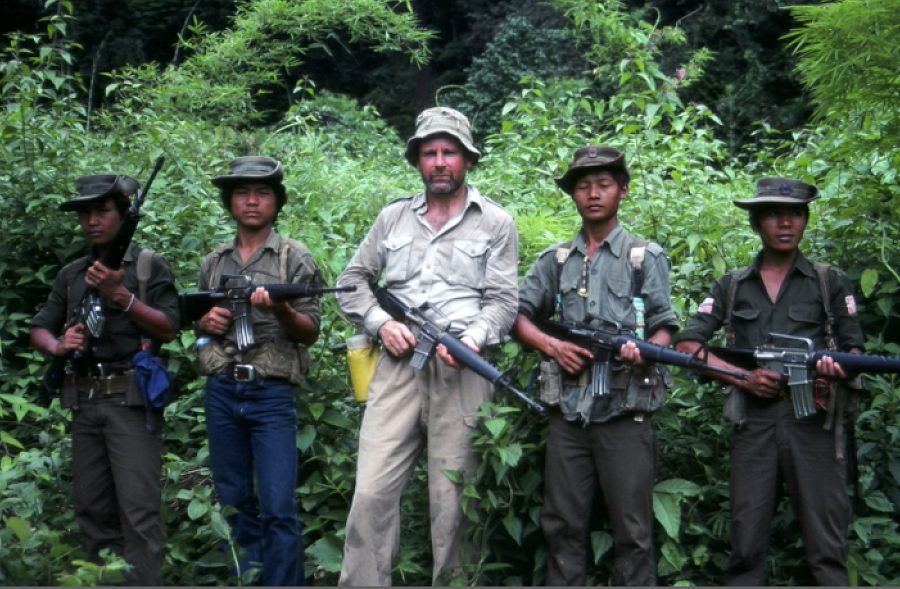 July, 1984. The KPNLF – Khmer People’s National Liberation Front – was the Anti-Communist guerrilla movement fighting the Soviet-backed Vietnamese Communists in Cambodia. When I was first there in 1961, Cambodia was then a land of serenity, with a gentle and tranquil people who were at peace with themselves and the world. Now it was a land of indescribable Communist horror.
July, 1984. The KPNLF – Khmer People’s National Liberation Front – was the Anti-Communist guerrilla movement fighting the Soviet-backed Vietnamese Communists in Cambodia. When I was first there in 1961, Cambodia was then a land of serenity, with a gentle and tranquil people who were at peace with themselves and the world. Now it was a land of indescribable Communist horror.
It was such a privilege to be with these brave men willing to wage war against that horror and bring freedom to their country. I told their tale in Turning Back the Terror, the February 1985 cover story for Reason magazine. (Glimpses of Our Breathtaking World #20 photo ©Jack Wheeler)
THE ROCK-HEWN CHURCHES OF LALIBELA, ETHIOPIA
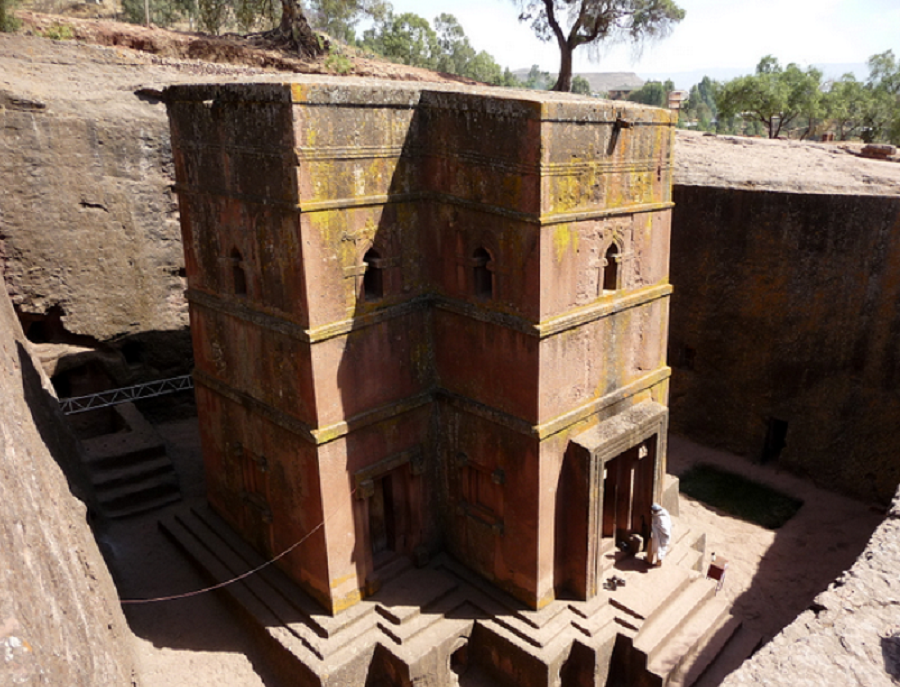 900 years ago, the Church of Saint George (Bete Giyorgis in Amharic) was not built – it was hand carved downwards from a horizontal rock ledge. There is nothing like the rock-hewn churches in Lalibela anywhere else in the world.
900 years ago, the Church of Saint George (Bete Giyorgis in Amharic) was not built – it was hand carved downwards from a horizontal rock ledge. There is nothing like the rock-hewn churches in Lalibela anywhere else in the world.
Christianity was established in Ethiopia in 330 AD and has flourished ever since. Experiencing the devotion still so very much alive in one of the oldest Christian countries on earth is inspiring. (Glimpses of Our Breathtaking World #26 photo ©Jack Wheeler)
THE SANDS OF THE TAKLA MAKAN
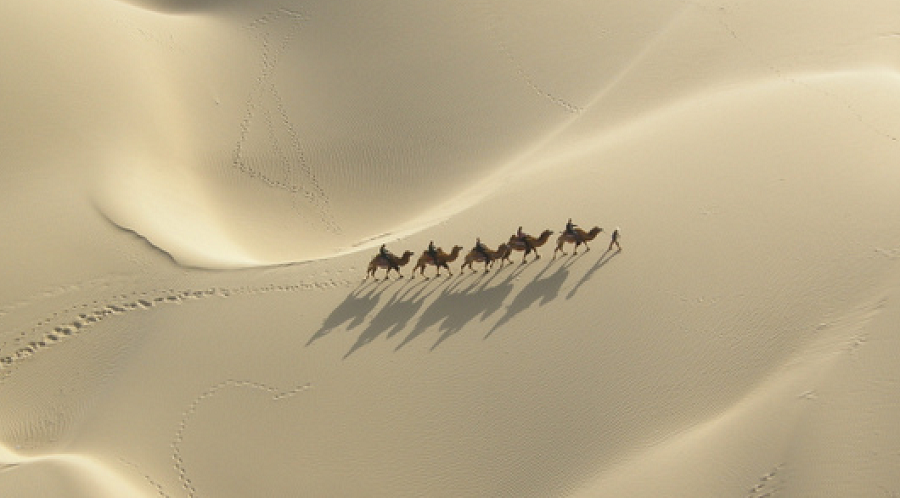 When Marco Polo crossed the Tien Shan mountains and reached the Silk Road oasis of Kashgar in 1273, he faced an enormous desert of endless dunes called the Takla Makan, meaning “You go in, you don’t come out.”
When Marco Polo crossed the Tien Shan mountains and reached the Silk Road oasis of Kashgar in 1273, he faced an enormous desert of endless dunes called the Takla Makan, meaning “You go in, you don’t come out.”
To avoid this fate, the Silk Road at Kashgar splits in two – above to the north of the dreaded sand sea via the oases of Aksu and Turfan, and underneath to the south via the oases of Yarkand, Khotan, Charchan and Charklik. The two routes came together beyond Lop Nor, the eastern extension of the Takla Makan, at the oasis of Dunhuang.
His father Niccolo and uncle Maffeo had earlier taken the northern route to first meet Mongol Emperor Kublai Khan, but now with Marco they took the southern route. They traveled in caravans of two-humped Bactrian camels, often crossing dunes on the edge – just like the photo you see. In 2008, I retraced Polo’s route along the southern route – part of it by motorized hang glider. He would be fascinated, I’m sure, to see what a camel caravan looks like from the air! (Glimpses of Our Breathtaking World #13 photo ©Jack Wheeler)
THE ETOSHA PAN
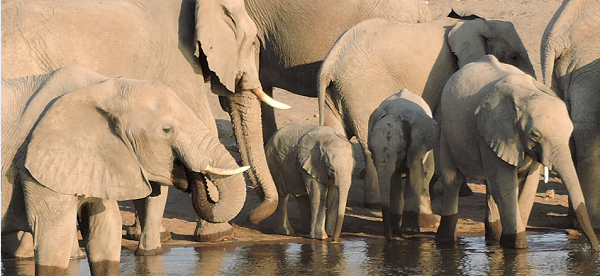 No, this isn’t the Serengeti. The Etosha Pan is a huge 2,000 square mile salt pan in northern Namibia that has an amazing abundance of African wildlife that flourishes in a desert – lots of elephants as you see, giant eland, huge oryx, kudu with the males sporting their glorious spiral horns, wildebeest, zebra, all kinds of antelope, plus lions and leopards galore hunting them.
No, this isn’t the Serengeti. The Etosha Pan is a huge 2,000 square mile salt pan in northern Namibia that has an amazing abundance of African wildlife that flourishes in a desert – lots of elephants as you see, giant eland, huge oryx, kudu with the males sporting their glorious spiral horns, wildebeest, zebra, all kinds of antelope, plus lions and leopards galore hunting them.
They all thrive on the available river and springs water amidst the surrounding mopane balsam woodlands. It’s one of Africa’s least known yet most astounding wildlife spectacles. Come during the dry winter months of July-September when the animals gather around the waterholes. You’ll never forget it. (Glimpses of Our Breathtaking World #291, photo ©Jack Wheeler)

